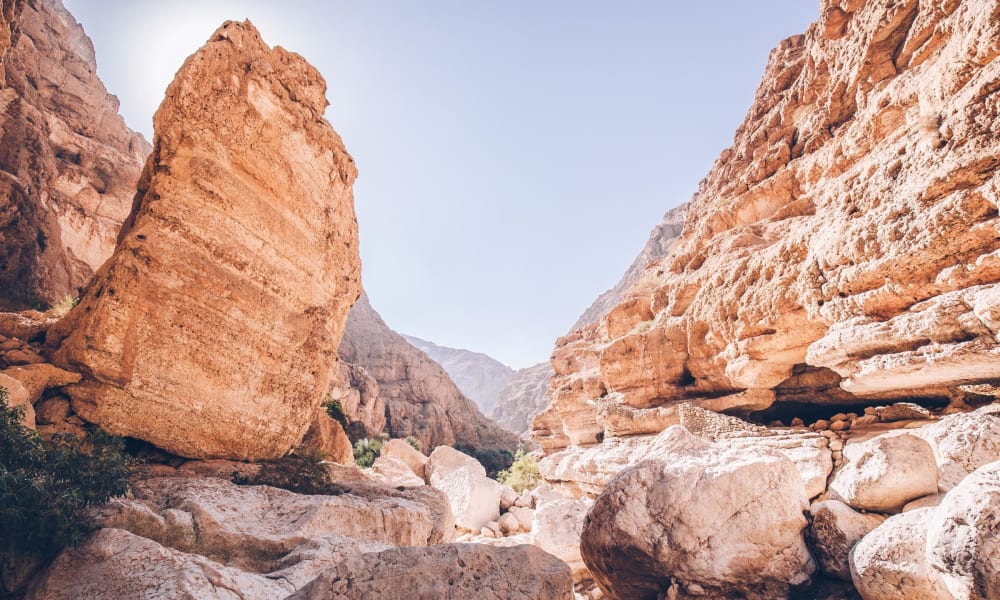
Oman
The Sultanate of Oman is located in the southeast of the Arabian Peninsula and differs, both politically and scenically, strongly from the neighboring states. Oman is still largely unknown as a vacation destination, yet the Sultanate offers optimal travel prerequisites: The country has been voted one of the 12 safest destinations in the world three times in a row and the infrastructure is extremely well developed.
- 10 Quick Facts about Oman
- Culture and tradition in Oman
- What codes of conduct should be respected?
- Language of communication
- Being a woman in oman
- Tipping
- Clothing
- Dress code - how do I dress appropriately?
- Geography and regions
- Oman's regions
- Oman's landscapes
- Oman - when is the best time to travel?
- What is the climate & weather like in Oman?
- History and politics



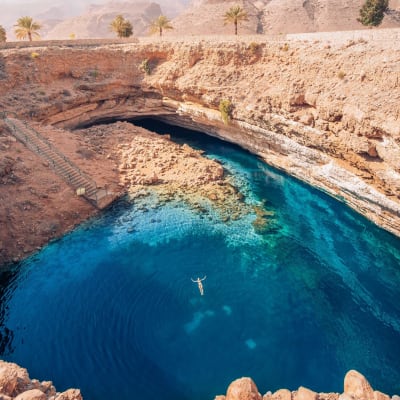
10 Quick Facts about Oman
1# Location
Oman is located in the southeast of the Arabian Peninsula and borders the United Arab Emirates, Saudi Arabia, and Yemen.
2# Language
The official language of Oman is Arabic, but English is also very common as a language of commerce.
3# Population
Oman is one of the most sparsely populated countries in the world with a population of 4.52 million (2021).
4# Culture
Omani culture is very peaceful, open, and hospitable.
5# Weekend
The weekend in Oman is from Friday to Saturday. Friday is the Muslim holiday.
6# Religion
95% of Omanis are of the Muslim faith, predominantly Sunni and Ibadi.
7# Safety
Oman is one of the safest travel destinations in the world.
8# Government
The Sultanate of Oman is an absolute monarchy, which also has a constitution.
9# Currency
The unit of currency in Oman is the Omani Rial (OMR). 1 rial is equal to 2.42 euros or 1 euro is equal to 0.41 OMR (June 2023).
10# Tipping
Also in Oman, the common tip surcharge is 10%.
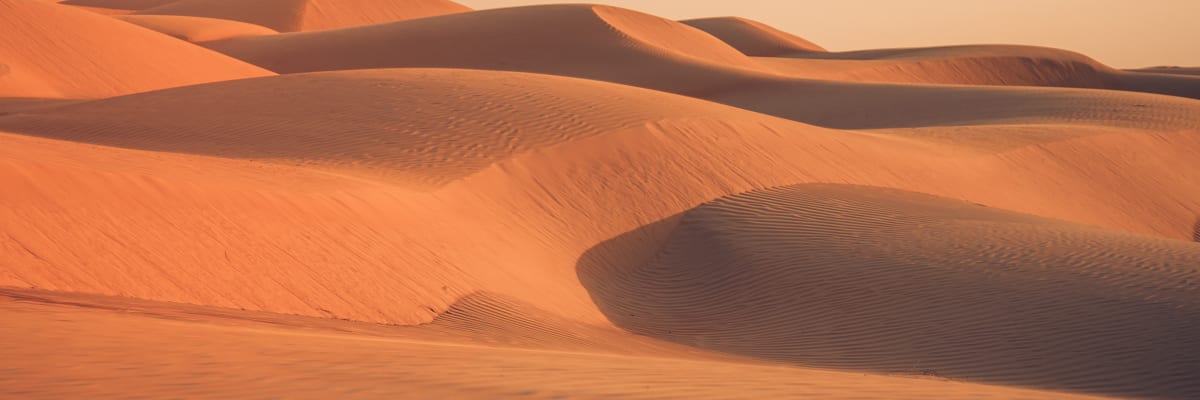
Culture and tradition in Oman
Oman combines tradition and modernity like hardly any other Arab country. While the essential aspects of the Arab culture have been preserved for centuries, at the same time, the society modernized and today combines traditional customs and traditions with openness and tolerance. The open-minded and hospitable culture makes the Sultanate a very unique destination.
What codes of conduct should be respected?
Oman is considered a very tolerant country and the Omanis are incredibly hospitable and helpful to strangers. Inappropriate or unfavorable behavior is unlikely to be addressed directly by the reserved Omanis, which makes it even more important to remember a few basic etiquette principles in advance. After all, as a traveler, you also want to treat the locals with respect.
Dos
Accept invitations – it is considered rude to turn down an invitation for a drink. Plus, you really shouldn’t miss out on the excellent Omani coffee and some dates either.
Show respect and gratitude Smile and laugh – enjoy your stay in this beautiful country, even the locals will be friendlier to you
Don'ts
Taking photos of people without asking is considered rude, but most Omanis will agree to a photo if asked for permission politely
Avoid pointing your finger or arm at anyone
Before entering a mosque, check to see if it is open to visitors
Inappropriate clothing – shoulders and, knees should always be covered
Language of communication
The official language of Oman is Arabic, however, especially in the cities and among younger people, English is already very common. If there are any communication problems, the open-minded Omanis will even try and help communicate with gestures and hand signs. If you want to please the locals, you can of course learn some vocabulary in Arabic.
Hello
Goodbye
Yes
No
Thank you
Sorry
Being a woman in oman
Unlike some other Arab countries, women and men in Oman are legally equal. Both women and men drive cars, go to work and hold public office. Education is highly regarded in the Sultanate, and many young women are beginning to study, and more and more are pursuing careers. Moreover, women in Oman do not have to wear veils, except in the mosque.
Oman is also a very safe destination for foreign women. You can move freely and travel alone without any problems. However, there are some behavioral guidelines you should follow as a woman: refrain from wearing short or tight-fitting clothing – shoulders and knees should remain covered. Avoid physical contact with local men – it is also not customary to shake hands with a man. If you feel more comfortable, you can cover your head with a simple shawl.
Tipping
There are no set rules for tipping in Oman. Generally, the tip is at your discretion and should be given according to your satisfaction. About 10% of the invoice amount can serve as a guideline. For service providers such as cab drivers, a fixed price is given and tipping is not necessarily expected here. In hotels and restaurants, a service charge is usually already included in the bill, again it is up to your discretion if you want to give an additional tip. For tour guides and drivers, you should consider tipping about three euros per day.
Clothing
The Omanis’ clothing is very traditional. Typically, men wear a light-colored, ankle-length garment and a small round cap on their head. Women typically wear long pants with a knee-length shirt over them. Many women also wear a headscarf and a black coat in public. Among Bedouin women, the burqa is widely used as a face covering, and its main function is to protect against the sun and sand. As a traveler, you are not expected to follow the same dress code as Omanis, nevertheless, you should still respect the local tradition and wear loose clothing that covers shoulders and knees.
Dress code - how do I dress appropriately?
Oman is a Muslim country and values tradition in many ways. At the same time, the population is very open-minded and cosmopolitan. This is also reflected in the clothing, as you do not have to wear a veil or headscarf in Oman. Nevertheless, you should follow some guidelines when choosing your clothes. In general, pants and skirts should reach at least the knee. If you wear a loose T-shirt that covers your shoulders, you won’t have to worry about being looked upon at askance. Depending on where you are staying, there are other rules to follow:
At the hotel
In hotels and resorts, the dress code for travellers is very casual. Here, even short clothing is not a problem and you can relax by the pool in a bikini or swimsuit without any worries.
In the desert
To protect yourself from the heat and sun, it is recommended to wear long and loose clothing in light colors and a head covering in the desert. You should bring enough warm clothes for the cold nights.
In the wadis
In the rock pools of the Wadis, where the local population also bathes, you should cover up to your knees. Again, it is advisable to wear shorts and a T-shirt over your swimwear in the water. However, in the more secluded pools, you can go swimming in your usual swimwear.
At the beach
Even at the beach, the dress code is generally seen as a bit more relaxed for foreigners than for locals. However, out of respect for Oman’s culture, clothing that provides more coverage should be worn on public beaches. In the water, for example, you can wear a T-shirt and shorts over your swimwear. Going nude or topless on the beach is not allowed.
In the mosque
At religious sites, the dress code for foreigners is also a bit stricter. According to the country’s customs, men and women in the mosque wear long clothes that cover the entire body. Here as a woman, you should also cover your hair with a headscarf. Shoes must be removed before entering the mosque.
Islam and ramadan in Oman
Oman is a predominantly Muslim country. About 86% of the total population is Muslim, of which the largest part belongs to Ibadi Islam. Part of this rare form of Islam is the special tolerance and respect for other religions in the country. The remaining 14% of the population are Christians and Hindus, most of them immigrants without Omani ancestry. The traditional culture of the country is closely linked to Islam so that the religion still has a significant influence on everyday life. One of Oman’s most important traditions is the fasting month of Ramadan. For four weeks, Muslims abstain from eating and drinking between sunrise and sunset and the daily breaking of the fast does not take place until after sunset. The highlight of the festivities is the three-day Eid at the end of Ramadan. A trip during this time will give you a special and authentic insight into the Muslim culture. However, even as a tourist traveling during Ramadan, you should refrain from eating and drinking in public.

Omanis and bedouins
With an area almost as large as Germany and a population of just under five million, Oman is one of the most sparsely populated countries in the world. The Omanis are known for their extraordinary hospitality and openness. You will surely encounter their kindness again and again during your stay. Whether in the form of an invitation to an Omani coffee, traditionally accompanied by dates, or through their willingness to help in all matters. By the way, you should always accept an invitation since anything else is considered impolite. The Bedouins are one of the oldest tribes in Arabia and are firmly anchored in the culture of Oman. Classically, they are desert dwellers who live as nomads. Today, they account for only about 5% of the population and have long ceased to be classic nomads. Nevertheless, even though modern technology and lifestyle have reached the Bedouins, many of them still live in close connection with nature and their history and tradition.

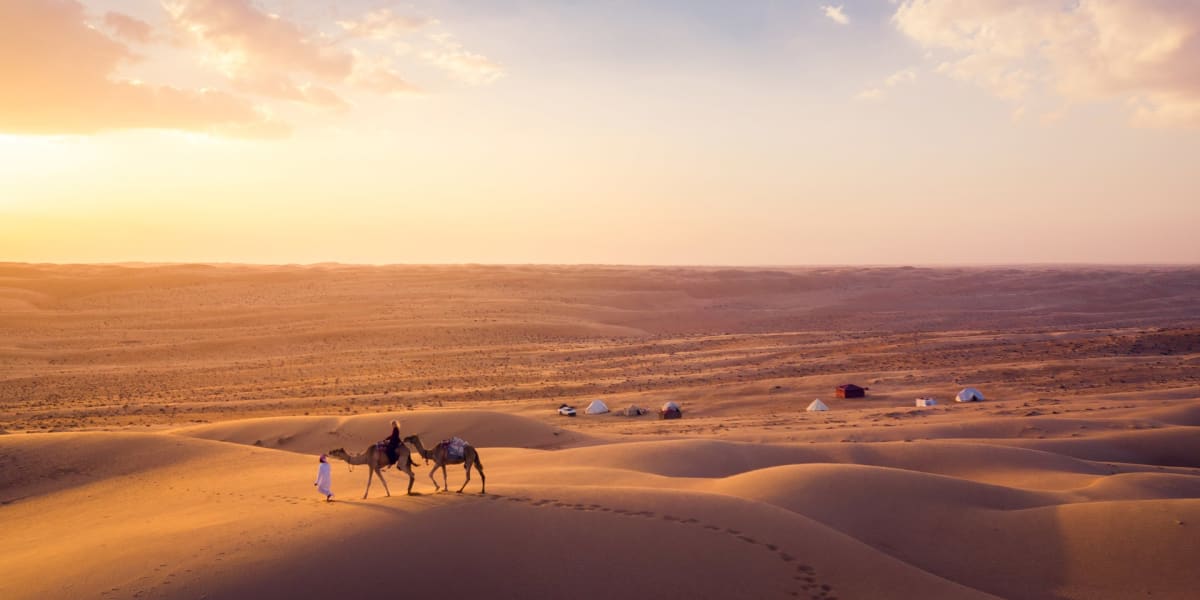
Are you ready to travel Oman?
Geography and regions
Oman is located in the east of the Arabian Peninsula, bordering the United Arab Emirates, Saudi Arabia, and Yemen. The capital region around Muscat is located on the north coast, between the Gulf of Oman and the Hajar Mountains. Oman’s mountains extend from the Musandam Peninsula to the easternmost tip of the country. The Rub al-Chali, the largest sand desert in the world, dominates the center and south of the Sultanate. On the coast and in the Dhofar region, the landscape becomes again more diverse and surprisingly green.
Oman's regions
A vibrant metropolis and a remote mountain world, Caribbean sandy beaches and rugged fjord landscapes, dry desert, and lush green vegetation – hardly any other country is more diverse than Oman. The country’s regions differ significantly from one another and are each a highlight on their own.
Muscat - the capital
On one side the Hajar Mountains, on the other the Gulf of Oman, in between lies Muscat, lined with beautiful sandy beaches. The capital of Oman proves that tradition and modernity do not have to be mutually exclusive. Here you can expect magnificent Arabic buildings such as the huge Sultan Qabus Mosque and modern establishments such as the Royal Opera House. Lively beach promenades invite you to stroll and in the small alleys of the Muttrah souk or Old Muscat, you will find a world like from 1001 Nights.

Salalah
Paradisiacal sandy beaches, turquoise waters, fantastic diving spots, and impressive landscapes, no wonder that Salalah is also called the “Caribbean of the Orient”. Salalah is the capital of the Dhofar region in the south of Oman and lies directly on the Indian Ocean. The annual monsoon between July and September provides a subtropical climate. This leads to lush green vegetation and the best conditions for the cultivation of mango and banana plantations as well as incense trees. A rather unusual picture in the otherwise so dry Oman.

Musandam
If Salalah is the “Caribbean of the Orient”, Musandam would be the “Norway of Arabia”, apart from the climate of course. The northern exclave of Musandam is geographically cut off from Oman, but scenically this remote region is definitely worth a visit. Here, the mighty foothills of the Hajar Mountains plunge directly into the blue depths of the Arabian Gulf. This creates an impressive fjord landscape with untouched peaks, hidden bays, and a fascinating underwater world with fantastic diving spots.

Nizwa
Nizwa is a very old oasis city in the north of Oman, about 200 kilometers from the capital Muscat. Though the city has been extensively modernized in the meantime, its long history can still be experienced in some places, such as the impressive fortress of Nizwa or the souks, the traditional markets of the city. Here you can also buy the finely crafted silver jewelry that the city is famous for. As the most important market and trading center in the region, Nizwa is the ideal starting point for discovering the impressive mountains of the Hajar range.

Oman's landscapes
Oman is an incredibly diverse country and is characterized by the most varied landscapes: endless sand dunes and barren desert landscapes, mystical mountain worlds with impressive gorges and bizarre rock formations, green fertile oases, and Caribbean-like coastal regions with dreamlike sandy beaches. This diversity and rugged beauty make the country a unique travel destination.
Deserts – Wahiba Sands & Rub al-Chali
Endless expanses and sand as far as the eye can see – if you want to experience a real desert, Oman is the place to visit. Deserts and semi-deserts cover most of the country. The beautiful sand desert of the Wahiba Sands is the home of the Bedouins and is one of the most popular travel destinations in Oman. Unique desert camps make an overnight stay under the endless starry sky a magical experience. The Rub al-Chali translated as “the empty quarter”, is the largest sand desert in the world and impresses with sand dunes up to 200 meters high. It is located in the south of the Arabian Peninsula.

Wadis – Wadi Shab, Wadi Bani Khalid and Wadi Tiwi
Wadis are dried up river courses and valleys that mostly occur in desert areas. In Oman, the wadis present themselves as oases in the middle of the mountains or the desert. The green canyons lie between towering rock formations and invite you to swim with their emerald green natural pools. Among the most beautiful wadis in the country are Wadi Shab and Wadi Tiwi: surrounded by palm groves and mango trees, you can enjoy the crystal clear water here and hike through the spectacular river valley. Wadi Bani Khalid in the barren Hajar Mountains is also very idyllic.

Mountains - Jebel Akhdar Mountains & Jebel Shams
A large part of Oman is characterized by spectacular mountain scenery. The Hajar Mountains stretch over 450 kilometers from the Musandam Peninsula in the north to the easternmost headland of the country. This mystical mountain landscape is also home to Jebel Shams, Oman’s highest mountain at 3,009 meters. From the summit you can enjoy fantastic views over Wadi Nakhar, the “Grand Canyon of Oman”, with rock faces up to 2,000 meters high. A further highlight is Jebel Akhdar, the green mountain, with its terraced fields and a wide plateau near the summit.

Underwater World
It may sound surprising, but Oman’s underwater world is among the most diverse in the Arabian Sea and even the Indian Ocean. Colorful coral reefs, sea turtles, dolphins, rare fish, and exciting shipwrecks make Oman’s coast a paradise for divers. The Daymaniyat Islands in the Gulf of Oman are a protected marine nature reserve and a special destination for diving and snorkeling. Those who prefer to relax on the beach will also get their money’s worth in Oman: along the 1,700-kilometer coastline, one dreamy sandy beach follows the next!

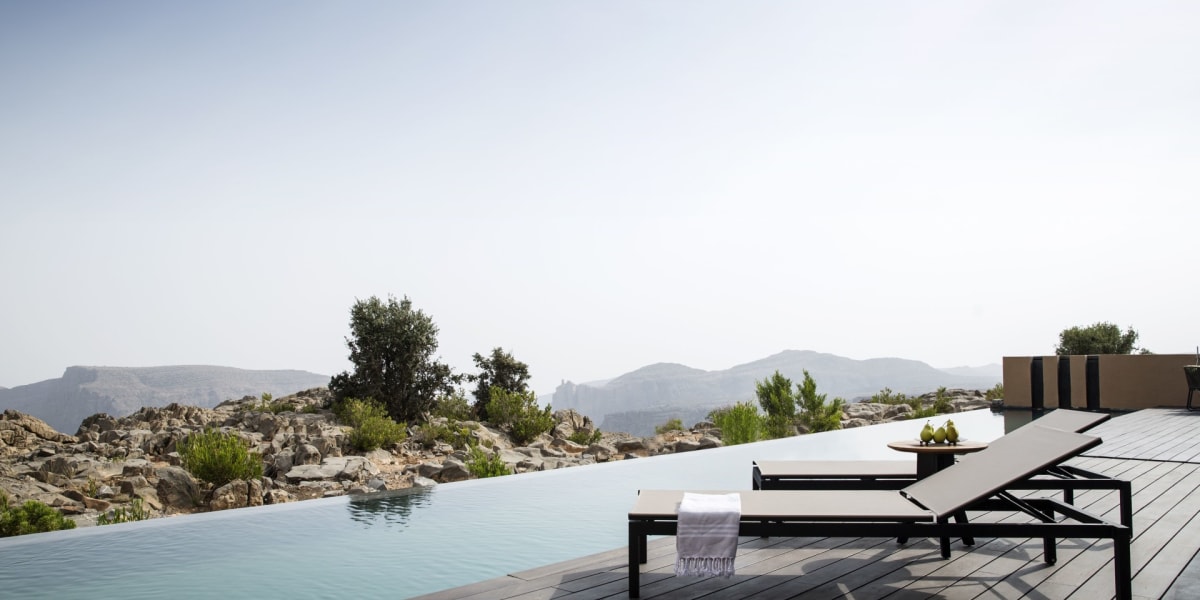
Are you looking for the perfect hotel?
Oman - when is the best time to travel?
Principally, Oman is a year-round destination with warm temperatures of about 30 degrees. Nevertheless, there are some climatic differences between the seasons and the regions of Oman. From July to September, the so-called Khareef determines the region around Salalah. This monsoon brings rain and very humid weather to the beach destination. In general, very hot temperatures occur throughout the country during the summer months. A somewhat milder climate awaits you between October and April: In the north, temperatures are then between 16 and 30 degrees, in the southern region around Salalah between 25 and 32 degrees.
What is the climate & weather like in Oman?
In general, the climate in Oman is characterized by very hot summers and short, mild winters. The further into the country you go, the drier and hotter it gets. The coastal regions, on the other hand, have a more subtropical climate. Between July and September, the monsoon Khareef brings rain and sultry heat to the southern coastal region around Salalah.
North-East Coast
The subtropical climate on the northeast coast awaits you with warm winters and hot summers. With relatively high humidity, the climate here is warm and humid throughout the year, but without much rainfall. While daytime temperatures in winter are around 22-25 degrees, in summer they reach around 36-39 degrees, with peak temperatures of 47 degrees. Even at night, it cools down only a little.
Hajar mountains
he Hajar Mountains are located in the northeast of the country, with peaks up to 3000 meters high. The climate in the Hajar Mountains is more temperate. Here the winters are rather cool, at high altitudes also with temperatures below freezing. In summer, temperatures reach up to 30 degrees, but at night it cools down significantly. In autumn and winter, sporadic rainfall is to be expected.
Desert Regions
Oman’s desert areas have a hot and dry climate. Winter is comparatively cool, with daytime temperatures of up to 25 degrees and nighttime temperatures of 10 to 12 degrees. In summer, however, it gets extremely hot, with daytime temperatures around 41 to 44 degrees. In rare cases, there can be short, heavy rain showers in winter.
Dhofar
The Dhofar region in the south of Oman attracts people with warm tropical temperatures between 25 and 32 degrees all year round. However, it is important to bear in mind that the climate from July to September is characterized by the so-called Khareef, a hot and humid monsoon from the Indian Ocean. The sometimes heavy rainfall transforms the otherwise rather dry area into a blooming landscape, which attracts tourists from the entire Arabian Peninsula. Therefore, we rather recommend the months of October to April as a travel time.
History and politics
Like many other countries in the Arab world, the Sultanate of Oman is an absolute monarchy. Executive, judicial and legislative powers are vested in the head of state, the Sultan. As an Arab and Islamic state, politics and religion are closely linked in Oman. Nevertheless, the very moderate government distinguishes Oman from most other Arab states. The legal system, for example, is very progressive and closely aligned with many Western states.
Oman in the past and the present
Its strategic location as a trade route between the East and the West has always played an important role in Oman’s history. One of the oldest trade routes in the world, the Frankincense Route, passes through Oman. It is therefore not surprising that the roots of the Omani people go back to a nation of traders and seafarers. In the 20th century, under the extremely conservative government of Sultan Said ibn Taimur, Oman was long an underdeveloped nation and virtually inaccessible to visitors. In 1970, the incumbent Sultan was deposed by his son Qaboos ibn Said. He reformed and modernized the country from the ground up. Within a short time, a modern state with a well-developed infrastructure and a progressive social, health and education system was created. Since 2020, Sultan Haitham bin Tarik has continued his predecessor’s moderate policies.

Safety in Oman
Even if the geographical location on the Arabian Peninsula does not necessarily suggest it, Oman is one of the safest travel destinations in the world. A key reason for the country’s very low crime rate is certainly because the population in Oman is doing relatively well economically. Only the border region to Yemen should be avoided by tourists. Also, health care is generally very good, but in remote regions, this can not always be fully guaranteed. Please check the current travel and safety information before your trip.

